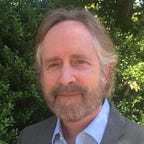The Circle that Brandborg Built
Conservation visionary Stewart Brandborg
Chiseled into the rockface of the nation’s conservation legacy are deep and lasting imprints from many outsized visionaries — from nature writer John Muir, conservationist Aldo Leopold, science writer Rachel Carson, Arctic activists Olaus and Mardy Murie and wilderness champion Stewart Brandborg.
Brandborg, who served at the helm of The Wilderness Society from 1964 to 1976, is among those whose inspiration and endless toil galvanized action and secured a wilderness legacy in America for generations to come. He passed away on April 14.
As a wildlife biologist in the early 1950s, Brandborg studied the life history and habitat of the Idaho Mountain Goat. But Brandy, as he is better known, also made a life-long study of activism and mentoring the “citizen leaders” he inspired who would champion the cause of wilderness conservation in every corner of the nation.
In his book, “The Promise of Wilderness,” historian James Morton Turner describes Brandy as “a bear of a man…deep voiced, and devilishly charismatic. He could give a busy taxi cab driver reason to care about wilderness and he could hold the attention of a senator on a street corner. His personality was magnetic, drawing activists in, inspiring them, and sending them home with a sense of personal and public purpose.”
In 1956, while serving on the conservation staff at the National Wildlife Federation, he was elected to the governing council of The Wilderness Society. He joined the small Wilderness Society staff in 1960 as a special assistant to Howard Zahniser, the executive director. Brandborg was hired to manage grassroots organizing, membership and fundraising.
The skills that came naturally to Brandborg — mentoring advocates and mobilizing citizens throughout the country — were essential to lining up support for congressional approval of the Wilderness Act of 1964 and making that law work in the years following. In the early 1960s, some regions already had established grassroots advocates for protecting wild places, but many had not.
The Wilderness Act, Brandborg said, was written by “one guy” — Howard Zahniser, who pushed the bill through dozens of drafts and hearings between 1956 until 1964, when the bill finally won approval in Congress and was signed into law by President Johnson. Tragically, Zahniser died in May of 1964, just months before the law was signed.
Brandborg was elected to fill Zahniser’s big shoes at a critical time for the Wilderness Act and the conservation movement.
“The interested public,” Brandborg wrote in 1964, “must assume a broad and continuing responsibility for working under the procedure of the Act to bring additional units into the National Wilderness Preservation System.”
The Wilderness Act laid out a 10-year time frame for securing wilderness recommendations from federal agencies with deadlines at years three, seven and ten. It fell to Brandborg to begin the arduous task of pushing for review and positive recommendations by the appropriate agencies for wilderness status for 34 primitive areas in the national forests and wildness-quality lands in the national parks and wildlife refuges.
In 1966, Brandborg described the challenge of “bringing up new leaders to carry the Wilderness Preservation System into the far future — when there may be challenges unheard of — and solutions undreamed of now.”
Those observations ring true today: “These coming years … will test our power to the limit: our ability to communicate the need for preserving wilderness; our depth of conviction and willingness to follow through on our commitments as citizens; and above all our basic faith in the American people, who are moving so fast and crowding so closely, and needing wildness so much more today than ever before.”
Brandborg served as executive director at The Wilderness Society from 1964 to 1976. During his tenure, more than 70 wilderness areas in 31 states were protected by Congress. In the years following, he took on new challenges as a conservation leader serving at the National Park Service and organizing training for activists. He remained no less committed to wilderness advocacy and mentoring in his later years, from his home in Montana.
In a recent conversation, he described his life’s work as “building the circles” — mobilizing local support by “putting people into working circles.” He described it as a long and laborious process but one that determines the fate of conservation efforts. Today, local citizen leaders still provide the muscle and clout required to get land designated as federally protected wilderness.
The immeasurable circle that Brandborg built over nearly seven decades is still growing.
